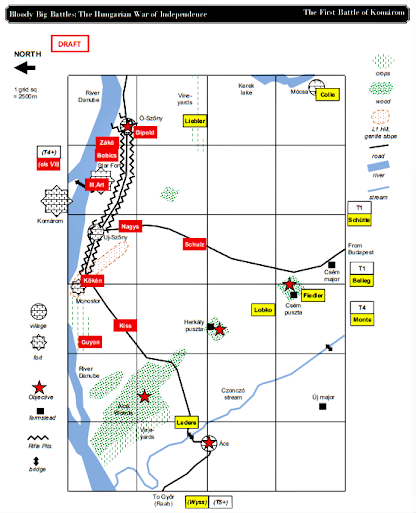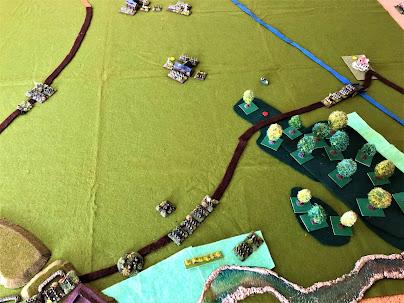In 1848, the largest fortress in Europe was Komárom (I believe). Its strategic significance came from its location at the confluence of two major rivers, the Váh and the Danube, between Vienna and Budapest. It therefore exerted a major influence on operations during the Hungarian War of Independence. Four large battles were fought outside its walls. Its garrison was the last Hungarian force to surrender.
Our Hungary 1848 campaign reached its halfway mark with the First Battle of Komárom (26 April 1849). Rather than recite the course of the game, I'll use this post to offer some more general observations.
In fact, we fought it three times this month. I had run the scenario a couple of times several years ago when I first wrote it. I therefore knew it was pretty solid, but it still needed more testing. First let me describe the general situation:
Scenario map for the First Battle of Komárom
The Hungarian army is breaking out of Komárom. The battle starts after the initial night assault that stormed the Austrian siege lines. It is now at the point where the Hungarians have reorganized and are ready to renew their attack. Meanwhile, the Austrian siege corps has received substantial reinforcements. There are five objectives at stake spread around the table. One is a wood in which huge quantities of Austrian supplies were parked. Two are manor farms that anchored the Austrian defensive line. Two village objectives represent the opposing sides' lines of communication.
1. The first playtest was with the core group of players that has fought the whole campaign so far. To avoid scenario-spoilers, I won't describe the plans or the action. In summary: the Hungarian attack inflicted such heavy losses on the Austrians that on Turn 6 the Austrian players were ready to concede. Yet the Hungarians ran out of time to take the now lightly-held objectives, and it ended up as an Austrian win. This provoked post-battle debate about scenario balance; whether it should be 9 turns long rather than 8; what part was played by luck or by good or bad plans. I should note that the Hungarians also suffered from a 'Campaign Consequence'. Having lost the previous battle, their best units were blunted by losing their 'Aggressive' rating. Anyway, it seemed clear that further playtesting would be helpful.
2. In the interlude between group gaming sessions, I ran a solo playtest. I omitted the 'Campaign Consequence'. I deliberately replicated the Austrian initial plan (though it later mutated) but implemented an alternative Hungarian plan. This was touch and go. On Turn 6, Austrian counterattacks had succeeded to the point that they held all five objectives. However, the Hungarians managed to retake all of them, including three on Turn 8, for an emphatic Hungarian victory.
3. For the third playtest I recruited different players. I was really pleased that both C-in-Cs voluntarily wrote full appreciations. These were thoughtful analyses of the situation together with their resulting plans. Furthermore, both sides' plans were different from those in either of the previous playtests. The result was an absolute ding-dong battle. Both armies marshalled their attacks really well. Three of the objectives changed hands no fewer than eight times - taken, retaken, re-retaken ... inevitably, although either side could have won it in the last turn, it resulted in a draw. This was fitting, as neither side deserved to lose.
Reflections;
From my point of view as ref and playtester, this third game was a thoroughly successful evening to cap a successful series of playtests:
- The game itself was a terrific fight, attack and counter-attack, several objectives changing hands several times, a tense finish, and it seemed fair that it ended with honours even.
- Both CinCs did an excellent job pre-game of submitting proper appreciations, analysing the situation and working out good plans accordingly. It was great to see the wheels going round in the generals' brains.
- Including my solo effort, we’ve run this three times, with three different sets of plans, and got three close games with three different results. Thus it is winnable by either side. Also there are multiple viable options available to both sides. That’s as good a playtest result as I could ask for.
- The variety of objectives (all of which had historical justification, they weren't just arbitrary) generates a variety of ways to win, hence variety of possible plans. This is good for making it an interesting challenge and for providing replay value.
- Our multi-player format (two players a side) proved its value and resilience. Late arrivals, early departures and interruptions meant that none of the players was there for the whole time. Despite this, the game was able to continue uninterrupted. We finished the whole battle in under four hours.
- Dave T remarked on a virtue of the remote format versus a club night at the village hall. Normally he'd not really have bothered to read the scenario beforehand but would just turn up, see the troops on the table and push them around accordingly. For this game, he liked having to use the scenario map and briefing to make his plan ahead of time and said it felt more like being a general.
- The scenario has just enough variety of troop types to add nuance to the tactics: where to use the best troops (grenadiers, cuirassiers, etc.) to best effect; where to hide the fragile ones.
- The campaign format helps, as players are getting to know the characterful units as old friends: the Polish Legion, the 'red kepis', etc.



I played that one a couple years back with a buddy of mine. He was a new player to the system so I gave him choice of who he wanted to take. He took the Austrians.
ReplyDeleteI ended up winning as the Hungarians, not sure if it was my tactical brilliance or maybe his inexperience with a first time set of rules. He enjoyed the game though.
A month later I redid the scenario with my local gaming group and did not play just reffed. The Austrians squeaked out a win but if the Hungarians last turn die rolls hadn't been almost all lousy ones, I think they would have taken it.
Glad to hear you had a couple of good games with this scenario.
Delete